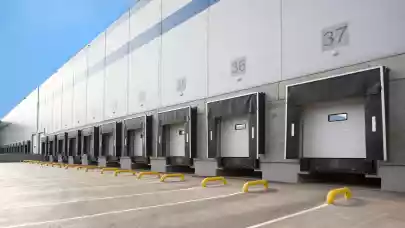
The Polish warehouse market experienced robust occupier demand in H1 2021, with take-up at 3.3 million sqm. Logistics companies and e-commerce retailers accounted for over half of all space leased. Supply also remains high, with 1.1 million sqm delivered in the first six months of 2021, which is a testament to strong market fundamentals. Very good absorption of space has resulted in a decline in availability, to 5.4% of the stock at the end of June. However, with the amount of space under construction at an all-time high of 3.4 million sqm, the vacancy rate is expected to stabilise in the upcoming quarters. Advisory firm Axi Immo presented its report "Polish Warehouse Market in H1 2021".
Warehouses continue to lure capital
The investment volume on the Polish commercial real estate market in the first half of 2021 stood at €2 billion across 60 transactions. The logistics and industrial sector accounted for 40% (€900 million) of the total. The largest transaction in the sector was the sale of the AEW portfolio to REINO Capital & IO Asset Management, with the latter two firms representing the Grosvenor Group. The portfolio is made up of five properties with a total area of 166,000 sqm, located in Upper Silesia, Poznań and Łódź. The second-largest deal was the takeover of properties located in Warsaw and Wrocław (124,000 sqm) by a confidential buyer. The third spot belongs to Savills Investment Management who acquired Castorama Stryków BTS (101,500 sqm) from Tritax EuroBox. We also observed heightened demand for urban logistics assets. 7R has been an active vendor in H1, with partial disposal of its park in Tczew (39,000 sqm plus 10,000 sqm development potential) to a Canadian investment fund BentallGreenOak and a sale of two warehouses within 7R City Flex Sosnowiec and 7R Siemianowice Śląskie (total area of 22,500 sqm) to a pan-European investment firm M7 Real Estate. High investor demand has resulted in yield compression. Currently, prime big box schemes are valued at 5.3-5.5% in net terms, while urban warehouses fetch approx. 4.75%.
„The key reason behind the optimistic mood among investors and their high appetite for industrial and logistics assets is the rise of e-commerce trade, which pushes up demand for warehouse space in Poland. What is noteworthy, the investment market in the warehouse sector has been dominated by prime properties, which accounted for 80% of the total. In addition, the appetite for smaller urban logistics assets is growing in line with the growth of e-commerce trade. This was evident particularly in Q2 2021. We still expect the most interesting transactions of 2021 to close in the second half of the year when negotiations that started in late 2020 and H1 2021 should be finalised,” comments Renata Osiecka, Managing Partner, Axi Immo.
In the first six months of 2021 developers completed 1.1 million sqm (-2% y/y) of modern industrial and logistics space, taking the total stock to the level of 21.7 million sqm (+11% y/y). The second quarter saw a rapid increase in the amount of space under construction, to an all-time high of 3.4 million sqm as of the end of June (+96% y/y). The largest schemes currently underway are: Panattoni BTS Amazon in Świebodzin, Western Poland (203,500 sqm), Panattoni CEL HUB - BTO Media Expert in Łódź (158,000 sqm), Hillwood Rokitno, Western Poland (112,500 sqm), Panattoni Poznań X – BTS DHL (108,000 sqm) and Hillwood Bydgoszcz (102,000 sqm). The share of speculative development remained relatively low at 29% at the end of June (up from 26% at the end of March).
The vacancy rate declined in Q2 to 5.4% (-130 bps y/y). Upper Silesia still has the largest amount of space available for immediate occupation among the main markets, in relation to its stock (8.7%), while Western Poland is at the other end of the spectrum (1.2%).
"Quick absorption of space and elevated costs of building materials are resulting in lower incentives on offer in new schemes in markets with the lowest availability. Robust demand has not yet spurred rental growth but we do expect some upward pressure on headline rents in the strongest markets in the upcoming months", says Anna Głowacz, Head of Industrial Agency.
Take-up in H1 2021 amounted to 3.3 million sqm (+40% y/y). Net demand, which does not take into account renewals, reached 2.5 million sqm, up from 1.8 million sqm a year earlier (+40% y/y). Out of the 15 largest leasing transactions signed in H1 2021, 11 concerned warehouse space dedicated fully or in large part to serving e-commerce trade. The largest transaction of H1 was signed by DHL with Panattoni. The logistics company took 109,000 sqm at a BTS building in Poznań, which will be used to service its client, an international online shop specialised in clothing. The second-largest lease of H1 was signed by an online furniture store and concerned 82,300 sqm at P3 Poznań II. The third spot belongs to a global e-commerce player who took 82,200 sqm at a BTS building in Gorzyczki near the Czech border, with Panattoni the developer
The largest group of occupiers taking space between January 2020 and June 2021 were traditional logistics firms (30%), companies operating in the e-commerce channel (23%), conventional retail (22%), production (8.4%) and construction/DIY/interior design (5.5%).
"We observe strong growth of e-commerce on the Polish market. As much as 23% of all space leased in the last 18 months was dedicated to serving online orders and returns. This includes transactions signed directly by online retailers as well as by their subcontractors, third-party logistics firms. Looking at the regions, Poznań was the leader of demand with 650k sqm leased in H1 2021, ahead of Upper Silesia (552k sqm) and Warsaw (546k sqm)", says Anna Głowacz.
"Good performance of the Polish economy will continue to drive demand for warehouse space. We expect robust industrial production and retail sales to continue to lead to high take-up on the market. As a result, the amount of space available immediately will fall in the short term, which will allow developers to commence a number of new schemes in the strongest markets. We are monitoring the price trajectory of building materials. Their further increases may trigger upward pressure on rents as higher building costs would be passed on to occupiers", summarises Renata Osiecka.



